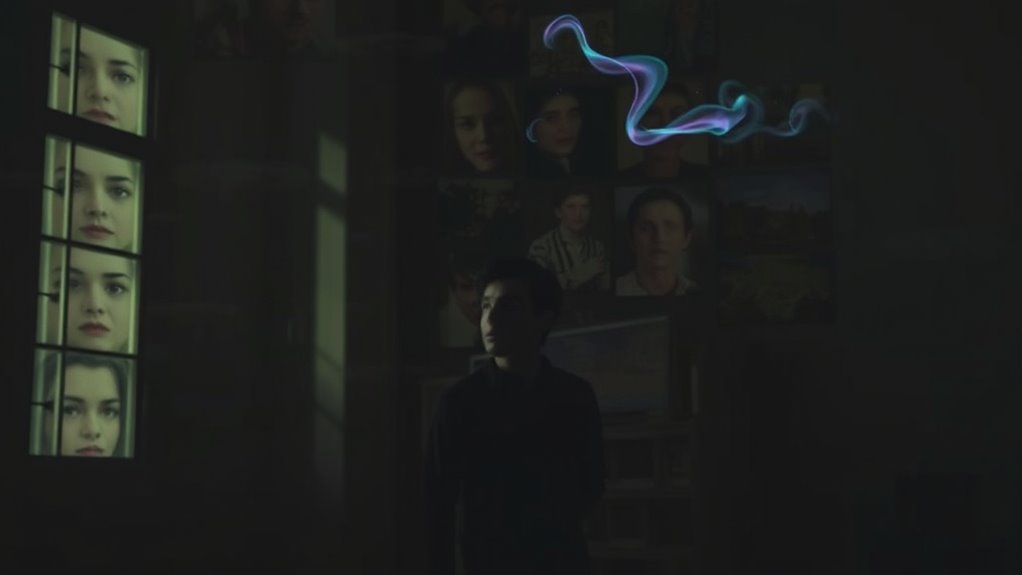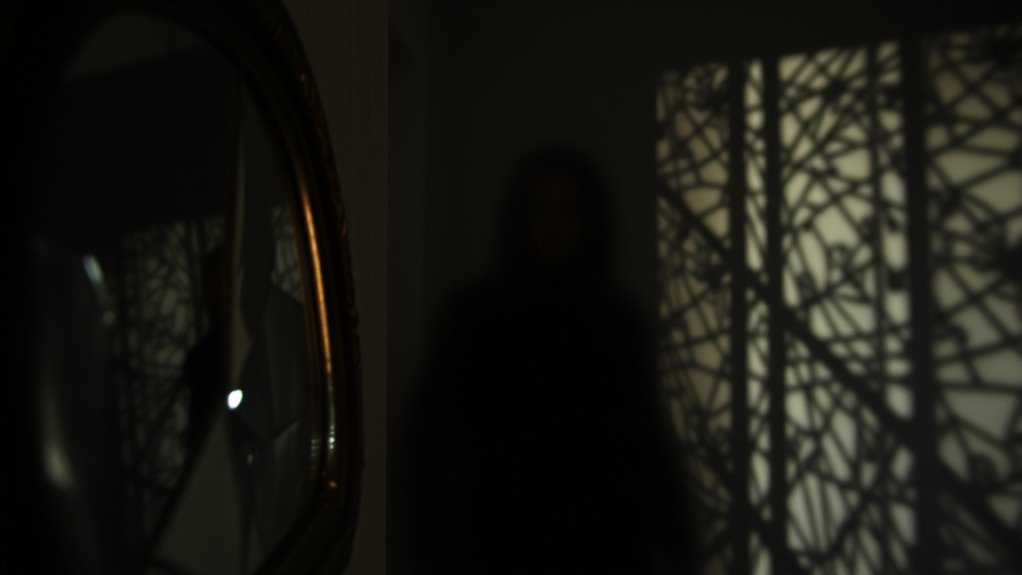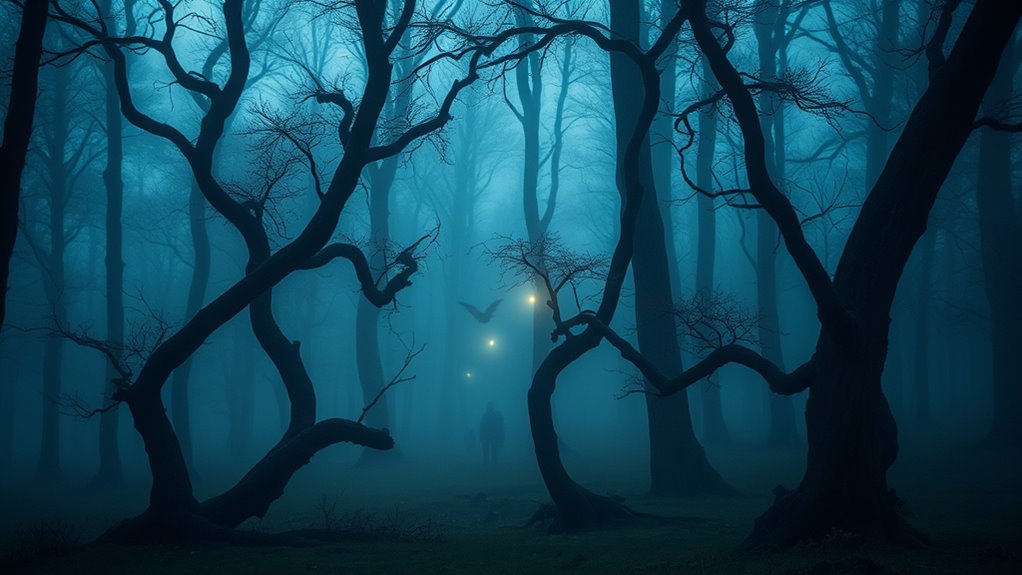When you see things that aren’t there, it’s often due to hallucinations, which happen when your brain misinterprets sensory information. These false perceptions can affect any of your senses, with visual and auditory hallucinations being common. Mental health disorders like schizophrenia, certain neurological conditions, or even extreme stress can trigger these experiences. Understanding why this happens can help you better cope and support those affected. If you’re curious about the underlying causes and treatment options, there’s more to discover.
Key Takeaways
- Hallucinations occur due to false perceptions involving sight, often linked to mental health disorders like schizophrenia or neurological conditions.
- Stressful experiences or trauma, such as PTSD, can trigger visual hallucinations related to past memories.
- Certain medications or substance use can lead to altered perceptions, causing individuals to see things that aren’t present.
- Neurological issues, like Parkinson’s disease, can disrupt normal brain function and contribute to visual hallucinations.
- Delusions, which are false beliefs, differ from hallucinations; they can coexist and complicate the perception of reality.
Understanding Hallucinations: Definition and Types

When you hear about hallucinations, you might think of strange sights or sounds that aren’t really there. Hallucinations are false perceptions involving any of the five senses, and they can manifest in various forms.
Visual hallucinations involve seeing things that don’t exist, while auditory hallucinations refer to hearing sounds that aren’t present. These sensory experiences are often linked to mental health conditions, with over 70% of individuals with schizophrenia experiencing visual hallucinations and 60%-90% facing auditory ones.
Factors like substance use, sleep deprivation, and neurological disorders such as Parkinson’s and Alzheimer’s can trigger these episodes. Additionally, hypnagogic and hypnopompic hallucinations occur during the shift between wakefulness and sleep, adding to the complexity of these phenomena.
Common Causes of Hallucinations

When you think about hallucinations, it’s essential to contemplate their roots in mental health disorders and neurological conditions.
Conditions like schizophrenia can lead to vivid experiences that blur the lines between reality and illusion.
Similarly, neurological issues such as Parkinson’s disease can trigger these unsettling perceptions, highlighting the complex interplay between our minds and brains.
Mental Health Disorders
Hallucinations can be a distressing symptom of various mental health disorders, often leading to a distorted perception of reality.
In schizophrenia, over 70% of individuals experience visual hallucinations, while 60% to 90% hear voices, making it a primary cause.
Bipolar disorder can also involve hallucinations during manic or depressive episodes, affecting your perception.
Major depression with psychotic features may lead to auditory hallucinations, amplifying feelings of despair.
Lewy body dementia affects about 80% of patients with visual hallucinations, particularly in later stages.
PTSD can trigger hallucinations related to traumatic memories, complicating your mental health further.
Understanding these disorders is vital for seeking appropriate treatment and managing symptoms effectively.
Neurological Conditions
Neurological conditions often play a significant role in the occurrence of hallucinations, affecting how you perceive reality.
Schizophrenia, for instance, impacts over 70% of individuals, leading to visual hallucinations and auditory hallucinations, like hearing voices.
In Parkinson’s disease, around 50% of patients experience PD psychosis, often manifesting as visual disturbances.
Alzheimer’s disease and Lewy body dementia frequently cause hallucinations in advanced stages, with visual symptoms being common.
Migraines can also lead to visual auras, with about one-third of sufferers experiencing these as hallucinations before or during headaches.
Additionally, Charles Bonnet syndrome affects visually impaired individuals, causing vivid visual hallucinations without any underlying mental illness, highlighting the neurological basis of these experiences.
The Difference Between Hallucinations and Delusions

When you experience hallucinations, your senses trick you into perceiving things that aren’t there, while delusions involve strong beliefs that don’t waver even with evidence against them.
Understanding the types of hallucinations and the nature of delusional thinking can help clarify these distinct experiences.
Sensory Perception vs. Belief
While it might seem that hallucinations and delusions are interchangeable, they represent distinct phenomena in how we perceive reality.
Hallucinations involve sensory experiences that occur without external stimuli, leading you to perceive things that aren’t there. These can affect any of your senses and may sometimes provide insight, allowing you to recognize their unreality.
On the other hand, delusions are firmly held false beliefs that persist despite evidence to the contrary. Often linked to mental health disorders like schizophrenia or certain neurological conditions, delusions can greatly impair your ability to function.
Unlike fleeting hallucinations, delusions are stable and can lead to a distorted understanding of reality, leaving you convinced of your false beliefs.
Types of Hallucinations
Hallucinations come in various forms, each affecting your senses in unique ways. You might experience visual hallucinations, where you see things that aren’t there, or auditory hallucinations, where you hear voices or sounds that don’t exist.
Tactile hallucinations can make you feel sensations on your skin, adding to the array of sensory experiences. Understanding these symptoms is essential for mental health diagnosis, as they often indicate underlying conditions like schizophrenia.
Unlike delusions, which are false beliefs you cling to despite evidence, you might recognize that your hallucinations aren’t real. Gaining insights into these differences helps in developing effective treatment strategies and improving your overall well-being.
Understanding Delusional Thinking
Understanding the nuances of delusional thinking is essential to grasping the broader landscape of mental health. While you might experience hallucinations as sensory experiences without external stimuli, delusions are firmly held cognitive beliefs that contradict reality.
Here’s how they differ:
- Hallucinations can affect any of your senses.
- Delusions often lack insight; you may believe falsehoods despite evidence.
- Both can occur in schizophrenia and other psychological disorders.
- Accurate diagnosis and tailored treatment are imperative for both.
Recognizing this distinction is significant, as it influences therapeutic approaches.
Understanding your experiences can lead to better outcomes in managing mental health conditions and enhancing overall well-being.
Diagnosis of Hallucinations

When someone experiences hallucinations, a thorough diagnosis is essential to pinpoint their causes and guide treatment.
A comprehensive diagnosis is crucial for identifying the causes of hallucinations and developing an effective treatment plan.
The process typically starts with a detailed medical history review and a physical examination to identify potential underlying causes. Healthcare providers ask specific questions about the nature, timing, and frequency of your hallucinations, which helps in the diagnosis.
Diagnostic tests, like EEGs and MRIs, may be employed to detect abnormal brain activity or structural issues such as tumors. Additionally, evaluations for mental health conditions are important to determine if they contribute to your symptoms.
An accurate diagnosis is critical for effective treatment planning and addressing the root causes of hallucinations, ensuring you receive the care you need.
Treatment Options for Hallucinations

Treatment options for hallucinations can vary markedly based on their underlying causes, so it’s important to tailor the approach to each individual.
Here are some common treatment strategies:
- Medications: Antipsychotic medications are essential for managing hallucinations in conditions like schizophrenia and bipolar disorder.
- Cognitive-behavioral therapy (CBT): This therapy helps you develop coping strategies to reduce distress associated with hallucinations.
- Addressing neurological conditions: Medications like acetylcholinesterase inhibitors can alleviate symptoms linked to diseases such as Alzheimer’s or Parkinson’s.
- Ongoing support: Regular monitoring and support from healthcare professionals guarantee effective treatment and adapt strategies as needed.
Understanding and addressing the underlying cause is critical for effective treatment and improving your overall quality of life.
How to Support Someone Experiencing Hallucinations

Supporting someone experiencing hallucinations can be challenging, yet your approach can greatly impact their well-being.
Start by providing reassurance and comfort without arguing about their perceptions; this can help reduce anxiety. Maintain a calm demeanor and acknowledge their experiences, fostering trust and open communication.
Guarantee their safety by monitoring their environment and intervening only if they’re at risk of harm. Encourage them to seek professional help, and offer to accompany them to appointments, where mental health professionals can provide tailored coping strategies.
Educate yourself about their specific condition and potential triggers for hallucinations, allowing you to better understand their experiences and offer appropriate support.
Your understanding and empathy can make a significant difference in their journey.
Frequently Asked Questions
What Causes Seeing Things That Are Not There?
Seeing things that aren’t there can stem from various causes. High fevers, intense grief, and stress can trigger temporary perception disturbances.
Mental health conditions, like schizophrenia or bipolar disorder, often lead to hallucinations. Neurological disorders, such as Alzheimer’s or Parkinson’s, can also play a role, with many individuals experiencing visual disturbances.
Additionally, substance use and certain medications might contribute to these experiences, making it essential to understand the underlying factors involved.
What Does It Mean to See Things That Are Not There?
Seeing things that aren’t there means your brain is interpreting sensory input in a way that doesn’t align with reality. You might experience vivid images or figures that others can’t see.
This can stir confusion or fear, especially if you believe what you’re seeing is real. Understanding that these experiences stem from your brain’s misinterpretation can help you navigate them, reducing anxiety and allowing you to seek appropriate support if needed.
Can We See Things That Are Not There?
Yes, you can see things that aren’t there. Various factors like stress, grief, or neurological conditions can lead to these experiences.
When you’re sleep-deprived or under intense pressure, your brain might misinterpret sensory information, causing you to perceive non-existent objects or figures.
Substance use, including alcohol and certain drugs, can also trigger hallucinations.
Even individuals with visual impairments may experience vivid images that aren’t actually present, highlighting the complexity of human perception.
What Are the 5 Types of Hallucinations?
Imagine you’re playing a classic video game, and suddenly, the screen glitches.
That’s similar to the five types of hallucinations you might encounter.
There’s visual hallucinations, where you see things that aren’t there.
Auditory ones involve hearing non-existent sounds.
Then, olfactory hallucinations let you smell imaginary odors.
You might also experience gustatory hallucinations, tasting things that aren’t real.
Finally, tactile hallucinations make you feel sensations on your skin that don’t exist.
Conclusion
In summary, understanding hallucinations can help you navigate the complex landscape of perception. Whether they’re born from stress, substance use, or mental health issues, recognizing the signs is vital. Remember, hallucinations aren’t a reflection of your reality; they’re like shadows dancing in the dark, distorting the truth. If you or someone you know is struggling, don’t hesitate to seek help. With the right support and treatment, clarity can return, illuminating the path to recovery.









